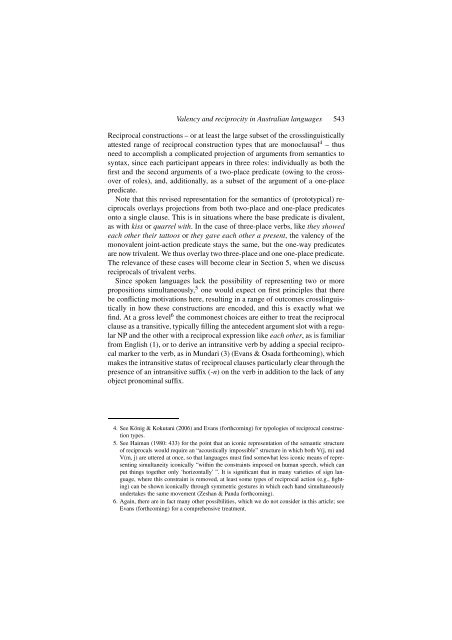Valency mismatches and the coding of reciprocity in ... - Linguistics
Valency mismatches and the coding of reciprocity in ... - Linguistics
Valency mismatches and the coding of reciprocity in ... - Linguistics
Create successful ePaper yourself
Turn your PDF publications into a flip-book with our unique Google optimized e-Paper software.
<strong>Valency</strong> <strong>and</strong> <strong>reciprocity</strong> <strong>in</strong> Australian languages 543<br />
Reciprocal constructions – or at least <strong>the</strong> large subset <strong>of</strong> <strong>the</strong> crossl<strong>in</strong>guistically<br />
attested range <strong>of</strong> reciprocal construction types that are monoclausal 4 – thus<br />
need to accomplish a complicated projection <strong>of</strong> arguments from semantics to<br />
syntax, s<strong>in</strong>ce each participant appears <strong>in</strong> three roles: <strong>in</strong>dividually as both <strong>the</strong><br />
first <strong>and</strong> <strong>the</strong> second arguments <strong>of</strong> a two-place predicate (ow<strong>in</strong>g to <strong>the</strong> crossover<br />
<strong>of</strong> roles), <strong>and</strong>, additionally, as a subset <strong>of</strong> <strong>the</strong> argument <strong>of</strong> a one-place<br />
predicate.<br />
Note that this revised representation for <strong>the</strong> semantics <strong>of</strong> (prototypical) reciprocals<br />
overlays projections from both two-place <strong>and</strong> one-place predicates<br />
onto a s<strong>in</strong>gle clause. This is <strong>in</strong> situations where <strong>the</strong> base predicate is divalent,<br />
as with kiss or quarrel with. In <strong>the</strong> case <strong>of</strong> three-place verbs, like <strong>the</strong>y showed<br />
each o<strong>the</strong>r <strong>the</strong>ir tattoos or <strong>the</strong>y gave each o<strong>the</strong>r a present, <strong>the</strong> valency <strong>of</strong> <strong>the</strong><br />
monovalent jo<strong>in</strong>t-action predicate stays <strong>the</strong> same, but <strong>the</strong> one-way predicates<br />
are now trivalent. We thus overlay two three-place <strong>and</strong> one one-place predicate.<br />
The relevance <strong>of</strong> <strong>the</strong>se cases will become clear <strong>in</strong> Section 5, when we discuss<br />
reciprocals <strong>of</strong> trivalent verbs.<br />
S<strong>in</strong>ce spoken languages lack <strong>the</strong> possibility <strong>of</strong> represent<strong>in</strong>g two or more<br />
propositions simultaneously, 5 one would expect on first pr<strong>in</strong>ciples that <strong>the</strong>re<br />
be conflict<strong>in</strong>g motivations here, result<strong>in</strong>g <strong>in</strong> a range <strong>of</strong> outcomes crossl<strong>in</strong>guistically<br />
<strong>in</strong> how <strong>the</strong>se constructions are encoded, <strong>and</strong> this is exactly what we<br />
f<strong>in</strong>d. At a gross level 6 <strong>the</strong> commonest choices are ei<strong>the</strong>r to treat <strong>the</strong> reciprocal<br />
clause as a transitive, typically fill<strong>in</strong>g <strong>the</strong> antecedent argument slot with a regular<br />
NP <strong>and</strong> <strong>the</strong> o<strong>the</strong>r with a reciprocal expression like each o<strong>the</strong>r, as is familiar<br />
from English (1), or to derive an <strong>in</strong>transitive verb by add<strong>in</strong>g a special reciprocal<br />
marker to <strong>the</strong> verb, as <strong>in</strong> Mundari (3) (Evans & Osada forthcom<strong>in</strong>g), which<br />
makes <strong>the</strong> <strong>in</strong>transitive status <strong>of</strong> reciprocal clauses particularly clear through <strong>the</strong><br />
presence <strong>of</strong> an <strong>in</strong>transitive suffix (-n) on <strong>the</strong> verb <strong>in</strong> addition to <strong>the</strong> lack <strong>of</strong> any<br />
object pronom<strong>in</strong>al suffix.<br />
4. See König & Kokutani (2006) <strong>and</strong> Evans (forthcom<strong>in</strong>g) for typologies <strong>of</strong> reciprocal construction<br />
types.<br />
5. See Haiman (1980: 433) for <strong>the</strong> po<strong>in</strong>t that an iconic representation <strong>of</strong> <strong>the</strong> semantic structure<br />
<strong>of</strong> reciprocals would require an “acoustically impossible” structure <strong>in</strong> which both V(j, m) <strong>and</strong><br />
V(m, j) are uttered at once, so that languages must f<strong>in</strong>d somewhat less iconic means <strong>of</strong> represent<strong>in</strong>g<br />
simultaneity iconically “with<strong>in</strong> <strong>the</strong> constra<strong>in</strong>ts imposed on human speech, which can<br />
put th<strong>in</strong>gs toge<strong>the</strong>r only ‘horizontally’ ”. It is significant that <strong>in</strong> many varieties <strong>of</strong> sign language,<br />
where this constra<strong>in</strong>t is removed, at least some types <strong>of</strong> reciprocal action (e.g., fight<strong>in</strong>g)<br />
can be shown iconically through symmetric gestures <strong>in</strong> which each h<strong>and</strong> simultaneously<br />
undertakes <strong>the</strong> same movement (Zeshan & P<strong>and</strong>a forthcom<strong>in</strong>g).<br />
6. Aga<strong>in</strong>, <strong>the</strong>re are <strong>in</strong> fact many o<strong>the</strong>r possibilities, which we do not consider <strong>in</strong> this article; see<br />
Evans (forthcom<strong>in</strong>g) for a comprehensive treatment.

















